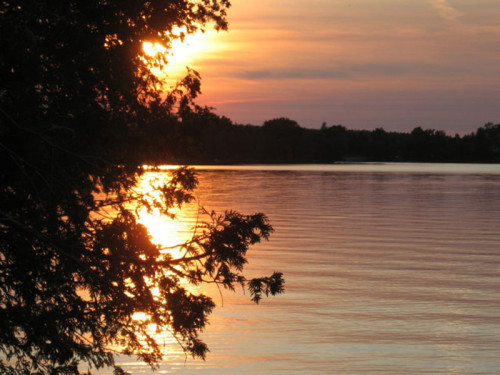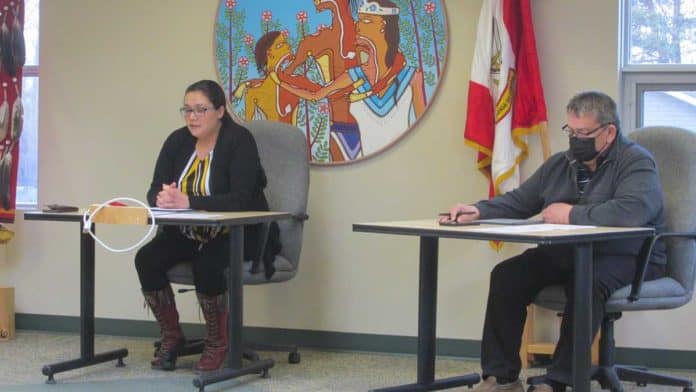LAKE MINDEMOYA – The results of fall walleye index netting (FWIN) show that Lake Mindemoya walleye are genetically unique, and that at this point the Ministry of Natural Resources and Forestry (MNRF) says it makes no sense to initiate a stocking program on Lake Mindemoya given the current status.
“One thing that surprised me is the gene pool/DNA results. Basically, the MNRF did this testing in 2009 and in 2015 we did our own testing and the two study results show that the Lake Mindemoya walleye are genetically unique,” said Al Holroyd of Cedar Grove Resort, after a meeting he and Central Manitoulin representatives had with MNRF district officials last week. “That was always the ministry’s feeling in not stocking other walleye in the lake, that we should not mix up the gene pool. We had felt it was the same old story-—they didn’t want to stock Lake Mindemoya. And now the studies and the DNA prove why.”
“They feel that the walleye are naturally reproducing, and are dead set against stocking because of the effects it would have on the gene pool,” said Mr. Holroyd.
“Obviously, we’re not happy to hear there is nothing we can do,” said Marcus Mohr, community development/outreach co-ordinator in Central Manitoulin. “Hearing that you would be wasting your time and money is disappointing, especially when you have the community will to try and improve something. I have community members contacting me by phone, email, Facebook and stopping me on the street to say they would volunteer to help improve the Lake Mindemoya fishery.”
On March 24, the MNRF had a video/teleconference presentation and meeting with Central Manitoulin to review the findings of the 2017 FWIN survey report on Lake Mindemoya along with details of the DNA sampling of walleye from Lake Mindemoya on specimens collected in 2015 by Mr. Holroyd. The review of this report was in relation to the potential of stocking Lake Mindemoya with walleye either through the MNRF Blue Jay Creek fish hatchery, a community hatchery or a combination of the two.
“The report basically states that the MNRF has no intention of stocking Lake Mindemoya as the lake is not at the point where it would typically be stocked, that the lake is self-sustaining and has healthy walleye, although numbers have been declining and did so drastically between 2005 and 2009,” said Mr. Mohr. “They state it will likely improve with time, with a positive note that there may be a turning point on the rainbow smelt issues as there were no invasive rainbow smelt caught in the 2017 FWIN survey, however, they were noted in the stomachs of some fish and the nests the use are not really designed to catch them. Further, that a unique strain of walleye exists in Lake Mindemoya and that if it got to a point where it would need to be stocked it should, in their opinion, be that generic strain. Finally, they stated that the cost is too prohibitive to raise walleye to size of around four inches so that they have the best chance of survival from predation. Mr. (Wayne) Selinger (MNRF biologist) stated you would need at least 50,000 four-inch walleye a year to make a difference in Lake Mindemoya and they don’t have the fish culture station infrastructure provincially to do a project of that size. They also stated that a community hatchery would be a waste of time and money.”
Mr. Selinger pointed out Lake Mindemoya supports a valuable fishery. “In response to public concern regarding noticeable changes over time in the walleye fishery and associated requests for supplemental stocking, MNRF Sudbury District has evaluated the status of the lake every four years since 1997 using the FWIN protocol. The latest survey was completed in 2017. MNRF Sudbury District has undertaken more assessment work on Lake Mindemoya than on any other waterbody in the district other than perhaps the French River.”
“The FWIN surveys have documented significant change over time resulting from the introduction of two invasive species (zebra mussels and rainbow smelt),” said Mr. Selinger. “Walleye biomass and abundance declined significantly between 2005 and 2009 but has been relatively stable since 2009. The introduction and proliferation of zebra mussels caused a reduction in lake productivity and walleye carrying capacity lowering nutrient levels and zooplankton abundance. Subsequent to the establishment of zebra mussels, rainbow smelt were introduced providing a new high energy food source significantly increasing walleye growth and body conditions and further altering population dynamics.”
“Lake Mindemoya is fundamentally a different ecosystem than it was 20 years ago, and fish populations have responded accordingly. The new reality for Lake Mindemoya is fewer bigger walleye,” wrote Mr. Selinger in the report.
Mr. Selinger confirmed that Lake Mindemoya walleye are genetically unique. “Tissue samples collected by Cedar Grove Resort in 2015 have been analyzed by MNRF research staff. The genetic results confirm that Lake Mindemoya walleye are genetically distinct from walleye in Lake Manitou (an introduced population and the available strain in the provincial fish culture system) and all other populations that MNRF has looked at in the North Channel, Georgian Bay and Lake Huron.”
“Yes, MNRF supports walleye stocking activities across the province and on Manitoulin, however, stocking on top of viable self-sustaining populations is strongly discouraged as it can do more harm than good.”
“Based on FWIN surveys completed between 1997 and 2017 Lake Mindemoya does not require stocking,” Mr. Selinger added. “Although there have been significant changes in the fishery over time associated with the introduction of invasive species, these changes are irreversible with or without stocking. Walleye are still recruiting naturally to the fishery and the lake continues to benchmark favourably against indices of expected abundance and sustainable mortality.”
“The genetic risks associated with stocking far outweigh the potential benefits and the true benefit of stocking would be negligible in comparison to what the lake seems to be able to support naturally,” continued Mr. Selinger. He wrote given the current status, “it makes no sense to initiate a stocking program on Lake Mindemoya.”
The MNRF is uncertain at this time as to whether another FWIN survey will be completed this coming fall. “Only time will tell if the pandemic, funding and staffing levels allow for a survey this year. If not, we will consider our ability to undertake,” added Mr. Selinger.
EDITOR’S NOTE: Please see next week’s Recorder for additional coverage.





